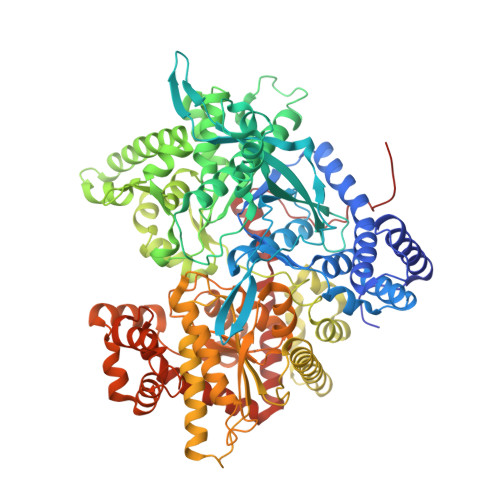Activator anion binding site in pyridoxal phosphorylase b: the binding of phosphite, phosphate, and fluorophosphate in the crystal.
Oikonomakos, N.G., Zographos, S.E., Tsitsanou, K.E., Johnson, L.N., Acharya, K.R.(1996) Protein Sci 5: 2416-2428
- PubMed: 8976550
- DOI: https://doi.org/10.1002/pro.5560051204
- Primary Citation of Related Structures:
2SKC, 2SKD, 2SKE - PubMed Abstract:
It has been established that phosphate analogues can activate glycogen phosphorylase reconstituted with pyridoxal in place of the natural cofactor pyridoxal 5'-phosphate (Change YC. McCalmont T, Graves DJ. 1983. Biochemistry 22:4987-4993). Pyridoxal phosphorylase b has been studied by kinetic, ultracentrifugation, and X-ray crystallographic experiments. In solution, the catalytically active species of pyridoxal phosphorylase b adopts a conformation that is more R-state-like than that of native phosphorylase b, but an inactive dimeric species of the enzyme can be stabilized by activator phosphite in combination with the T-state inhibitor glucose. Co-crystals of pyridoxal phosphorylase b complexed with either phosphite, phosphate, or fluorophosphate, the inhibitor glucose, and the weak activator IMP were grown in space group P4(3)2(1)2, with native-like unit cell dimensions, and the structures of the complexes have been refined to give crystallographic R factors of 18.5-19.2%, for data between 8 and 2.4 A resolution. The anions bind tightly at the catalytic site in a similar but not identical position to that occupied by the cofactor 5'-phosphate group in the native enzyme (phosphorus to phosphorus atoms distance = 1.2 A). The structural results show that the structures of the pyridoxal phosphorylase b-anion-glucose-IMP complexes are overall similar to the glucose complex of native T-state phosphorylase b. Structural comparisons suggest that the bound anions, in the position observed in the crystal, might have a structural role for effective catalysis.
Organizational Affiliation:
Institute of Biological Research and Biotechnology, National Hellenic Research Foundation, Athens, Greece. nikos@apollon.servicenet.ariadne-t.gr


















